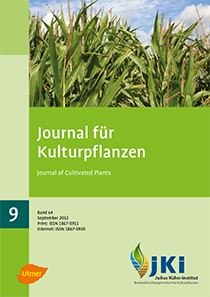Pest management strategies of the future with a focus on environmental compatibility and efficiency
Keywords:
Plant protection management, strategy, efficiency scores, pesticide risk indicator SYNOPS, status quo of chemical plant protection, reference farms network in agriculture and horticultureAbstract
In view of the global challenges facing agriculture, pest management remains essential for yield protection and quality assurance in food and industrial crop farming. EU Plant Protection Law forms the framework for two basic crop protection strategies of the future: integrated pest management (IPM) and organic pest management. Both strategies have many common features and, basically, only one main difference: a wide range of natural and chemical-synthetic pesticides can be used in IPM, whereas only pesticides made of natural substances can be used in organic farming. Infestation prevention and plant hygiene are, however, the top priorities in both integrated pest management and organic farming. In both strategies, the goal is to keep infestation levels low and to restrict the amount of pesticides used to the necessary minimum needed for effective crop protection.
Surveys conducted within the Reference Farms Network system of the Julius Kühn-Institut (JKI) and the German states revealed two interesting findings. The intensity of chemical pesticide use under the current conditions (market, crop rotation, variety, quality requirements, etc.) is already close to the necessary minimum and to open up remaining reduction potential will require an enormous investment of time and effort by consultants and extension services.
In long-term studies over multiple crop rotations, the JKI demonstrated that situation-dependent pesticide treatment plays an important role in achieving high nitrogen efficiency in plant production. In arable crops, the net energy output in IPM systems was approximately 40% higher than that of organic pest management systems, but the difference was much smaller under certain site-specific conditions, e.g. in the case of rye. These data indicate that organic farming has a less favourable energy intensity profile but a more favourable output-input ratio. Any significant increase in organic farming will inevitably lead to a significant decrease in the average yield per unit area of important major crops.
To characterize the environmental risk of chemical pest control the risk assessment model SYNOPS has been developed by the JKI. According to SYNOPS, the environmental risk potential of chemical pest control has decreased steadily over the last 20 years. Conversely, the applied volume of active ingredients per unit area of farming land has increased slightly in all spheres of activity in the last 10 years. This shows that risk reduction has nothing to do with volume reduction.
In agricultural practice, residual risks (hot spots) can remain even though risk reduction has been achieved. These hot spots must be identified and evaluated in order to implement specific amelioration measures which, in some cases, must be adapted to the specific regional conditions. Close cooperation between researchers, authorities and farmers is needed to focus attention on achieving an even better balance between high production levels and environmental compatibility.
Experience in the field of „minor uses“ has shown that the availability of a wide range of active ingredients is essential for securing the future of „minor crops“ such as fruits and vegetables, herbs and spices, and hops and grapes. Put in cautiously optimistic terms, the new EU plant protection package can provide such opportunities and can serve to counteract distortion of competition within the European Union.
Although there are still many open scientific questions, climate change will likely lead to an increase in pest pressure and to the invasion of new pest species. For this reason also, a significant reduction of the intensity of chemical pest control can hardly be expected, that is, unless breakthroughs are made in breeding and, perhaps, also in the acceptance of green gene technology.
DOI: 10.5073/JfK.2012.09.01, https://doi.org/10.5073/JfK.2012.09.01








